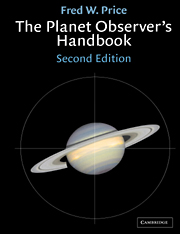Book contents
- Frontmatter
- Contents
- Foreword
- Preface
- Acknowledgements
- Abbreviations used in this book
- Introduction: Why observe the planets?
- 1 The Solar System
- 2 The celestial sphere
- 3 Telescopes and accessories
- 4 The atmosphere and seeing
- 5 Mercury
- 6 Venus
- 7 Mars
- 8 The minor planets (asteroids)
- 9 Jupiter
- 10 Saturn
- 11 Uranus
- 12 Neptune
- 13 Pluto
- 14 Constructing maps and planispheres
- 15 Planetary photography and videography
- 16 Photoelectric photometry of the minor planets, planets and their satellites
- Appendix: Milestones in Solar System exploration
- Name index
- Subject index
6 - Venus
Published online by Cambridge University Press: 05 August 2012
- Frontmatter
- Contents
- Foreword
- Preface
- Acknowledgements
- Abbreviations used in this book
- Introduction: Why observe the planets?
- 1 The Solar System
- 2 The celestial sphere
- 3 Telescopes and accessories
- 4 The atmosphere and seeing
- 5 Mercury
- 6 Venus
- 7 Mars
- 8 The minor planets (asteroids)
- 9 Jupiter
- 10 Saturn
- 11 Uranus
- 12 Neptune
- 13 Pluto
- 14 Constructing maps and planispheres
- 15 Planetary photography and videography
- 16 Photoelectric photometry of the minor planets, planets and their satellites
- Appendix: Milestones in Solar System exploration
- Name index
- Subject index
Summary
General
Venus is the second out from the sun of the two ‘inferior’ planets. It has a diameter at the surface of 7521 miles (12104 km), only a shade less than that of the Earth (fig. 6.1). Measured at the cloud tops the diameter is 7606 miles (12240 km). Because of this close similarity in size to the Earth, Venus has often been called ‘the Earth's twin sister’. The masses and therefore the densities and gravities are also similar. The resemblances end here, however, because the two planets are vastly different in other respects.
The mean distance of Venus from the sun is 67.2 million miles (108.2 million km) and varies from a perihelion distance of 66.8 million miles (107.5 million km) to the aphelic distance of 67.7 million miles (108.9 million km). The orbital eccentricity is 0.007 so that the orbit is very nearly circular in contrast to Mercury's orbit.
Venus comes closer to the Earth than any other celestial body except for the moon, a comet, an occasional meteor or an asteroid. At its nearest it is only about 100 times the moon's distance from us.
Venus journeys around the sun at a mean orbital velocity of 21.8 miles (35.1 km) per second and completes one circuit of the orbit in 224.7 Earth days, its sidereal period. Its mean synodic period, say from one inferior conjunction to the next, is 584 days.
- Type
- Chapter
- Information
- The Planet Observer's Handbook , pp. 102 - 134Publisher: Cambridge University PressPrint publication year: 2000



